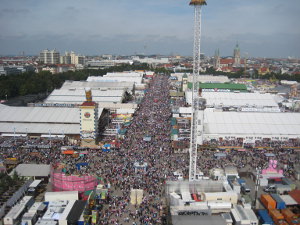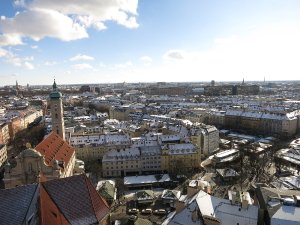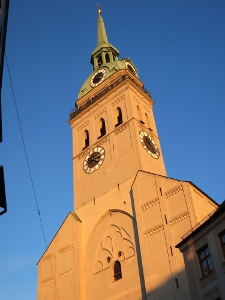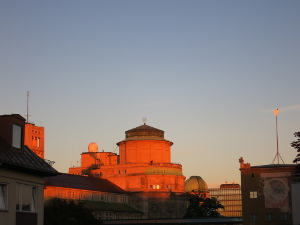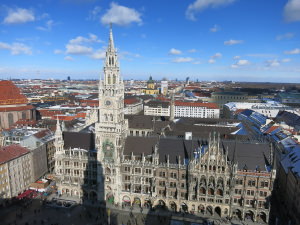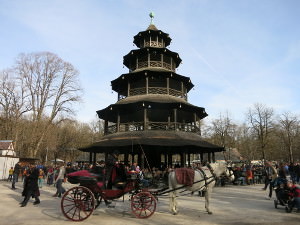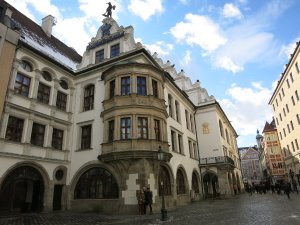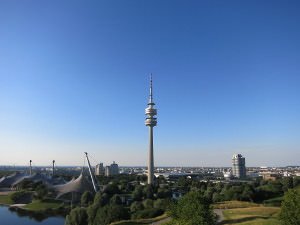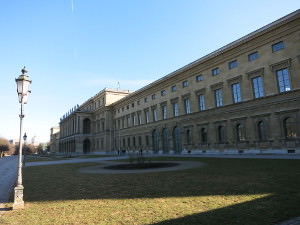Top 10 Things to See in Munich
Munich is a city full of attractions. We picked out our Top 10 things to See in Munich although there are a lot more things to do and see in Munich than there are on this list of course.
But with limited time these 10 Munich attractions have to be on every tourists and locals to-do list.
In order to make things even more convenient we created a nice map with all Top 10 Things to See in Munich locations at the end of this awesome article. Enjoy!
1. Oktoberfest
The Oktoberfest is THE happening of the year in Munich and also its so-called 5th season.
You will never ever hear a real inhabitant of Munich (born and raised or at least lived there for several years) say the word Oktoberfest though– in Munich/Bavarian dialect it’s just called Wiesn which means nothing else than meadow or lawn.
Nearly everybody might have heard about the biggest fair in the world (approx. 6 million visitors drink also 6 million liter of beer) and a lot of tourists maybe even you have already visited it, but not many know the origin of this madness which takes place every year from the penultimate weekend of September until the first weekend of October.
The first Wiesn was in 1810 on the occasion of the marriage of King Ludwig I. of Bavaria (back then the crown prince) and Therese of Bavaria (the princess) and took place as a horse raise. In the following years it developed more and more to the fair as we know it nowadays.
Continue reading in the article Wiesn for crucial tipps how to enter a tent, how to survive from 9h in the morning until the music ends at 23h and an explanation why the beer is stronger than the normal beer which the famous Munich breweries usually sell (what??!!? it’s stronger than the usual beer, that explains why I was so bloody drunk so fast). PROST!
2. Viktualienmarkt
The Viktualienmarkt is Munich’s oldest market and located just a few steps away from the Marienplatz.
The word “Viktualien” is from Latin origin and means nothing else than groceries. The market takes place every day since 1807 except Sunday’s and national holidays.
You can find all kind of food – vegetables, fruit, fish and meat – even oriental specialties or a horse butcher but also flowers, Bavarian snacks or a market stand only selling everything connected with honey.
The Viktualienmarkt is structured in different areas e.g. for fruit stands, vegetable stands, the butchers line and even a small “potato corner”.
Right in the middle of the market you find a beer garden – the specialty of this beer garden is the fact that beer from all six Munich breweries is served there (Augustiner, Hacker-Pschorr, Paulaner, Spaten, Hofbräu and Löwenbräu) – not to disadvantage any of the breweries the city took the decision that the offered beer takes turns.
Due to the fact that the Viktualienmarkt is very touristic the price level is appropriate high.
3. Sankt Peter (“Alter Peter”)
Sankt Peter is the oldest church of Munich and was founded in the 12th century.
In WWII it was nearly completely destroyed but due to big donations the reconstruction of the exterior could already be finished in 1951.
The big attraction of the Alter Peter as it’s called in the vernacular is the ascent of its tower giving you one of Munich’s best views incl. views over the Viktualienmarkt, Marienplatz and Neues Rathaus and on nice days even the Alps.
Entrance costs you only 2 .- € and takes you over 300 stairs up to the viewing platform at 56m – the tower itself is 91m high.
4. Deutsches Museum
If there is one museum in Munich which you can’t miss then it is the Deutsches Museum, Germany’s largest museum and the largest technical-natural scientific museum in the whole world.
The museum was opened in 1906 and experienced a lot of ups and downs until today.
In WWII it was nearly completely destroyed (up to 80 %) but could already reopen in 1948.
In 1983 a fire destroyed a huge part of the navy and the power machine section. Today round about 100.000 objects are displayed though there are permanent constructions going on until at least 2025 and therefore some parts are closed at the moment.
The most impressive exhibit (in my eyes as I still can remember the demonstration when I was a child 20 years ago), is the electricity exhibition including the “Faraday Cage”, which just re-opened after a long renovation period last year.
The cage explained in simple words: It’s a huge cage big enough for a person to enter and once it is closed electric lightings are banging on the cage and the person inside is not getting hurt by the high voltage – just impressive!
Plan one whole day for the museum, entrance fee is 8,50 € for adults and 3 .- € for students.
5. Marienplatz & Neues Rathaus
The Marienplatz is the main square of the city, underneath you find one of the biggest underground as well as S-Bahn stations.
Only two buildings from the pre-WWII era still can be found on the place, the Neues Rathaus and the building with number 21, all the other buildings have been completely destroyed during the war.
Every day at 11h and 12h and additionally from March until October also at 17h the carillon (Glockenspiel) of the Neues Rathaus is playing- hundreds of tourists standing on the Marienplatz headed towards the tower – quite a funny foto motive!
The Neues Rathaus itself was build from 1867 until 1909 in three phases in the neogothic style, the 85m high tower can be climbed.
6. Englischer Garten
The Englischer Garten is one of the world’s biggest parks and the biggest one in Munich. It’s divided into two parts by the urban freeway Mittlerer Ring.
The Southern part (and most visited one) has roughly 130 hectares, the Northern part ca. 230 hectares.
It was inaugurated in 1789 by the palatine elector Carl Theodor and officially opened in 1792.
The idea behind it was to open such a park in each garrison town of the Bavarian army for both recreation and also teaching the soldiers agricultural knowledge but also allowing the normal people to enter.
There are plenty of things to do in the Englischer Garten besides just laying in the grass and relaxing; below our personal Top 5 Things to do in the Englischer Garten:
+ Seehaus Im Englischen Garten: The audience occasionally might be a little bit snobbish but there is no beer garden in Munich where the sun is shining longer than here due to its nice locating right beside an artificial lake, the Kleinhesseloher See.
+ Eisbachwelle: Artifical wave in the Eisbach (little stream running through the park) which allows surfers doing their sports all year round, which they do indeed no matter if it’s summer or wintertime (Bus 100 or Tram 18, stop Nationalmuseum/Haus der Kunst).
+ Chinesischer Turm and Biergarten Chinesischer Turm: The Chinese tower was built between 1789 and 1790 by Johann Baptist Lechner after a draft from Joseph Frey and is the emblem of the Englischer Garten. It was damaged by fire several times and completely destroyed in WWII.
Between 1951 and 1952 it was rebuilt by Franz Zell and still remains today. In the 1970’s it was still possible to climb up the 25m tall construction, today you can’t climb up because of security concerns.
Around the tower is located the 2nd biggest beer garden of Munich with a capacity of up to 7,000 visitors serving you Hofbräu beer. Since 1989 on each 3rd weekend of July the Kocherball takes place (see section Kocherball, not online yet).
+ Monopteros
The Monopertos was finished in 1836 after a draft from Leo von Klenze and is build out of chalk from Kehlheim. Back in the 1970’s the monument was meeting point for hippies, artists and alternatives.
+ Mini-Hofbräuhaus
One of the smallest beer gardens in Munich and a real insider tip. You get served good food (not usual for a beer garden) and – correctly guessed – Hofbräu beer. It’s located in the Northern part of the park and can best be reached by bike.
Very dog friendly so should you as dogs are running around and under the tables all the time. It’s hard to find though, click here for google maps.
7. Hofbräuhaus
The Hofbräuhaus is one of Munich’s most visited tourist attractions offering Hofbräu beer for up to 1,000 guests and is amongst the world’s biggest restaurants.
The Hofbräuhaus as we know it today was finished in 1897 after the brewery itself was relocated in the Innere Wiener Straße/ district Haidhausen (today you find the Hofbräukeller there) with the original buildings of the brewery having been pulled down.
The original brewery Staatliches Hofbräuhaus in München as it’s officially called was founded in 1589 by Duke Wilhelm V. due to the fact that until that year no beer was brewed in Munich – it had to be imported expensively from other German cities like Einbeck (Lower Saxony).
After a big fire in 1987 the brewery was relocated a last time to it’s current premises in the district München-Riem producing up to 300,000 hl per year. The last beer at the Platzl was brewed in 1896.
Since a donation by King Maximilian II. the Hofbräu München is property of the Bavarian state. You might wonder what the shelves full of mugs are for:
If you have drunken enough beer in your life meaning you are a regular guest of the HB as it’s also often called you get a shelf space allowing you to lock away your mug after your stay at the HB.
8. Olympiapark (Olympiagelände)
The Olympiapark was the main scene of the Summer Olympics 1972 including the stadium, the premises for most indoor and swimming events, a huge aquarium and the athletes‘ lodging.
Since then the Olympic areal has seen thousands of sports events, concerts etc.
Until 2005 the former olympic stadium was home of Munich’s most popular football club FC Bayern München and with interruptions of TSV 1860 München before the clubs moved to the new stadium outside Munich.
The park in total is about 850.000 sqm large, its highest point (ca. 60 m) is the Olympiahügel (Olympia hill) – a hill made of rubbish of Munich’s destroyed buildings of WWII.
It’s also the highest elevation of Munich – on a nice day you can clearly see the Alps from its top. In summer a nice place to chill, play football or frisbee or to have a glass of beer or two in the small and cosy beer garden Olympiaalm (see also topic Top 10 beer gardens in Munich).
The general concept of the Olympiapark was made by the Stuttgart-based architecture office Behnisch & Partner.
The olympic areal has been built on the Oberwiesenfeld where the first airport of Munich was located. The Olympic Tower is 291m high and the 2nd highest building in Bavaria (after the television tower of Nürnberg).
The viewing platform is located at ca. 180m height and can be reached by an elevator. You also find an exquisite restaurant called Restaurant 181 (guess where the name comes from) on the platform.
9. Schloss Nymphenburg
The palace was a gift from elector Ferdinand Maria to his wife Adelheid in 1664 who finally was pregnant with the heir to the throne Max Emanuel.
The main building was finished in 1675, in the following years it was gradually enlarged to today’s state.
King Maximilian died here in 1825 and his great-grandson Ludiwg II. (Bavaria’s fairy tale prince) was born in the castle in 1845.
Elector Karl Theodor opened the connected park to the people in 1792. It took until 1823 until the park was completely finished. After the revolution in 1918 Schloss Nymphenburg became state property.
Today the palace and its huge park is one of Munich’s most visited attractions with more than 300.000 visitors per year. It can be visited all year round and contains four museums. The most known attraction is King Ludwig’s I.
Gallery of Bauties which contains paintings of 36 „beautiful“ ladies of all walks of life of the Munich society (including his longterm mistress Lola Montez).
10. Residenz München & Hofgarten
Germany’s largest palace located in a inner city and residence of the Bavarian dukes, electors and kings.
Today it houses one of Europe’s most important museums for spatial art.
The complex is a mixture of Renaissance, baroque, rococo and classicism. First building was already constructed in 1385 with the fortress Neuveste (the old position is marked with red paving stones).
Great parts of this first building were demolished by command of Maxiimilian I. in 1612. Major enlargements were the Antiquarium (constr. time 1568 – 1571) with the largest Renaissance hall Northern of the Alps, the Grottenhof (1581 – 1586), the Kaiserhof (1611 – 1619) and the Königliches Hof- und Nationaltheater (1811 – 1818). The theater was built by command of King Max I. Joseph and is still in use today.
Besides the mentioned extensions nearly each royal who inhabited the Residenz made changes to at least the premises she or he was living in including Ludiwg II.
At Odeonsplatz you find one of the entrances to the Hofgarten, a small park with elements of English and Renaissance architecture (the original Hofgarten was completely destroyed in WWII.).
Right in the middle you find a nice pavillon – the Dianatempel – where street musicians and dancers are entertaining the people.
All Top 10 Things to See in Munich in one map
More things to do in Munich (and if I have a closer look nearly all of them are also „musts“!
+ Flaucher/ Isarauen
+ Glockenbachviertel & Gärtnerplatz
+ Frauenkirche
+ Botanic Garden
+ Müllersches Volksbad + Gasteig
+ Auer Dult
+ Franzosenviertel/ Haidhausen
+ BMW World incl. BMW Museum
+ Königsplatz
+ Leopoldstraße + university
+ Maximilianeum
+ Friedensengel
+ Allianzarena
Continue reading about some of these other Munich top 10 things to do and see as soon as we update our „More things to do in Munich“.
In the meantime make sure to know about the hottest restaurants in Munich right now and continue reading about the best restaurants in Munich.
